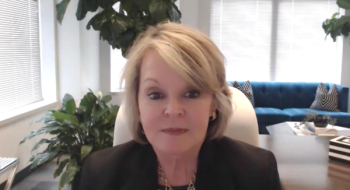
Patient Care Must Be an Ongoing Collaboration That Includes Multifaceted Concerns, Panel Says
The theme of ACCC Immediate Past President Ali McBride, PharmD, MS, BPS, BCOP, for his 2019-2020 term was “Collaborate. Educate. Compensate: A Prescription for Sustainable Cancer Care Delivery.” Nowhere was that more evident than in the panel discussion he led on day 2 of this year’s annual conference.
The theme of ACCC Immediate Past President Ali McBride PharmD, MS, BPS, BCOP, for his 2019-2020 term was “
McBride, clinical coordinator, hematology/oncology, Department of Pharmacy, The University of Arizona Cancer Center, was joined on the panel by:
- Al B. Benson III, MD, FACP, professor of medicine, Division of Hematology/Oncology, Northwestern University Feinberg School of Medicine
- Rebecca Kirch, JD, executive vice president, Health Care, Quality and Value, National Patient Advocate Foundation
- Barbara L. McAneny, MD, FASCO, MACP, chief executive officer, New Mexico Oncology Hematology Consultants, Ltd; immediate past president, American Medical Association
- Brenda Nevidjon, MSN, RN, FAAN, CEO, Oncology Nursing Society
- Randall A. Oyer, MD, ACCC president-elect; medical director, oncology, Penn Medicine/Lancaster General Health, Ann B. Barshinger Cancer Institute
- Melanie R. Smith, PharmD, BCACP, DPLA, director, Section of Ambulatory Care Practitioners, Member Relations, American Society of Health-System Pharmacists
- Lara Strawbridge, director, Division of Ambulatory Payment Models, Center for Medicare and Medicaid Innovation
They discussed the results of Resource and Reimbursement Barriers to Comprehensive Cancer Care Delivery, an ACCC survey originally piloted at the 2018 and 2019 annual meetings meant to gauge barriers to delivering the most effective and comprehensive cancer care. Following the 2019 meeting, 172 ACCC member programs responded to questions that covered 27 supportive oncology services, and this panel touched on 5 of them:
- Patient navigation
- Financial needs counseling and navigation
- Palliative care services
- Survivorship care planning
- Clinical trials
McBride opened the discussion by telling how more than half of the responding oncology practices said they had inadequate resources to provide nutrition, palliative care, financial services, or even genetic counseling. Most offer some supportive oncology services, but they vary. What they all agreed on, however, was the need for adequate staffing “to deliver supportive oncology services to all patients who need them.”
“We need to create a dissemination strategy to inform policy and oncology reimbursement,” McBride emphasized. “There needs to be sustainable care delivery. How does your organization do this?”
The results? Through the survey, the members of the panel helped develop a tiered comprehensive cancer care services matrix whose top 5 areas are those mentioned above, and explained in further detail below, that address such questions as what else is needed to add and/or grow this service and what members of the multidisciplinary team can and/or should provide this service.
Patient Navigation
“Navigation is a service, not a job description. Every person a patient comes in contact with has the job of navigating the patient through that part. Navigation is a process that needs to be hardwired into every single member of a team,” McAneny stated.
The panel agreed on the importance of patient navigation being a team effort.
“The idea is that when you meet a patient,” Benson noted, “you can link them with the appropriate person on the team. So start at the very beginning to identify what is important to that patient.”
Cost is also a factor in this area, as there needs to be adequate funds for both the physicians and their patients.
“There needs to be clearly designated time and resources to each team member so they can do their job and it doesn’t become unsustainable over time,” Strawbridge added. “We must recognize the investment in staff and resources and provide rewards in the form of reimbursement.”
Financial Needs Counseling and Navigation
The survey results showed there is
“What is the return on investment?” McBride asked.
“Financial toxicity used to not be a thing,” Kirch responded. “We must be amplifying the voices of what patients and their families need.”
McAneny agreed, saying, “Even with Medicare, the out-of-pocket costs are enormous. It costs me $15 to collect the $5 copay. Look at the insurance industry. Stop playing the cost-shifting game. Two-thirds of bankruptcies are triggered by a medical event, and two-thirds of those have insurance.”
Palliative Care
The overarching theme during this segment of the panel was that the patients and their caregivers need to be heard and understood and that it is every care team member’s responsibility. Patients can be educated on the role of palliative care and comprehensive community cancer programs can develop and offer referral pathways.
“Patients with advanced lung cancer live longer with palliative care services,” Oyer noted, “but only 19% are referred. Who needs to be educated? The patients or the system? We need a system that changes.”
Kirch noted the reach of online training in this regard. “We need to train professionals. Start thinking how we can support these services. Everyone is responsible for providing palliative care to patients. Everyone needs to have basic conversations with patients about how treatment can impact lives.”
“Nurses, pharmacists, physicians. It’s everybody’s job,” Smith said. “It’s an ongoing situation, not a fixed event.” Nevidjon agreed, calling for an investigation in to “what we are teaching in our education programs.”
Survivorship Care Planning
The panel agreed that survivorship care planning in oncology needs to be a dynamic process. The increasing numbers of survivors, over time, experience a lot of other comorbidities that the oncology community is not prepared to deal with, so primary care needs to be embedded with oncology, stated McAneny.
However, “primary care is in a crisis situation. In primary care, the shortage of providers is worse than in oncology. How do we handle 10 million patients and growing? What will be the long-term outcomes of people getting immunotherapy? This is one component of what we will need to do in the long run,” Benson added.
“Patients groups remind us that they think of survivorship as starting when a patient is diagnosed,” Strawbridge said.
Proposed solutions in the survey include providing a survivorship care plan to every patient and communicating this information to the patient’s primary care physician (PCP). Again, collaboration was the name of the game, especially when working with PCPs on transfers of care and follow-up.
Clinical Trials
The panelists agreed that the current system needs updating because it is rife with issues. Major changes are needed. Oyer noted that the top 3 issues are staff resources, program infrastructure, and lack of patient understanding of the process, but that a solution is top of mind.
McAneny agreed that the system is flawed. “We need a system that opens trials in under a month. We need trial participants that more reflect the country we serve. It’s a cumbersome and clunky system that desperately needs to be streamlined,” she stated.
“We’re constantly under pressure to make sure our populations include a diverse population. Patients want to be treated in the communities where they feel most comfortable. But those small local hospitals don’t have the resources,” Oyer responded. “We are going to develop a new roadmap on how to find a trials. So we can address the needs of traditionally undermet populations in our country.”
“It’s been a learning curve,” McBride concluded.
Newsletter
Stay ahead of policy, cost, and value—subscribe to AJMC for expert insights at the intersection of clinical care and health economics.















































